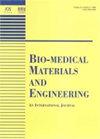用于输尿管支架的聚乙烯吡咯烷酮水凝胶涂层:安全性和性能评估
IF 1.3
4区 医学
Q4 ENGINEERING, BIOMEDICAL
引用次数: 0
摘要
背景:输尿管支架常用于泌尿外科。然而,植入后可能会出现支架表面结壳和感染、输尿管粘膜损伤等并发症,给患者带来不适。目的:我们打算证实聚乙烯吡咯烷酮(PVP)亲水涂层的生物安全性及其润滑特性,用于输尿管支架的表面改性,以减少摩擦,提高患者的舒适度。方法:在以往研究的基础上,我们开发了一种用于输尿管支架表面改性的 PVP 亲水涂层。我们首先研究了支架涂层提取物的细胞毒性、皮内刺激性、迟发型超敏反应和急性全身反应。我们还进一步测定了支架的断裂强度、保持强度和动态摩擦力。结果:所有实验组的细胞存活率均大于 70%。未观察到超敏反应、全身毒性反应或明显的皮内反应。上述结果表明,改良支架的测试结果符合 ISO 10993-5:2009(细胞毒性)、ISO 10993-10:2021(致敏性和刺激性)、ISO 10993-11:2017(急性全身毒性)的要求。在人工尿液中长时间浸泡后,超滑性能没有明显变化。结论:我们的研究结果证实了用于输尿管支架表面改性的 PVP 亲水涂层的安全性和润滑特性。该涂层的性能有望减少支架植入后的并发症,从而提高患者的舒适度,减轻医疗负担,具有良好的临床应用前景。本文章由计算机程序翻译,如有差异,请以英文原文为准。
Polyvinylpyrrolidone hydrogel coating for ureteral stent: Safety and performance evaluation
BACKGROUND:Ureteral stents are commonly used in urology. However, complications such as encrustation and infection on the surface of the stent, and injury to the ureteral mucosa can occur after implantation, causing discomfort for patients. OBJECTIVE:We intend to confirm the biosafety of polyvinylpyrrolidone (PVP) hydrophilic coating and its lubrication properties for surface modification of ureteral stents to reduce friction and improve patient comfort. METHODS:Based on our previous studies, we have developed a PVP hydrophilic coating for surface modification of ureteral stents. We firstly investigated the cytotoxicity, intradermal irritation, delayed type hypersensitivity, and acute systemic reactions of stent coating extracts. We further characterized the break strength, retention strength, and dynamic friction of the stent. RESULTS:The cell survival rate of all experimental groups was greater than 70%. No hypersensitivity reaction, systemic toxicity reaction, or obvious intradermal reaction were observed. The above results indicate that the test results of the modified stent meet the requirements of ISO 10993-5: 2009 (Cytotoxicity); ISO 10993-10:2021 (Sensitization and Irritation); ISO 10993-11:2017 (Acute Systemic Toxicity). After soaking in artificial urine for an extended period, there was no obvious change in its super-slip performance. CONCLUSION:Our results confirm the safety and lubrication characteristics of PVP hydrophilic coating for ureteral stent surface modification. The performance of this coating has the potential to reduce complications after stent implantation, thereby improving patient comfort, reducing medical burden, and has a good clinical application prospect.
求助全文
通过发布文献求助,成功后即可免费获取论文全文。
去求助
来源期刊

Bio-medical materials and engineering
工程技术-材料科学:生物材料
CiteScore
1.80
自引率
0.00%
发文量
73
审稿时长
6 months
期刊介绍:
The aim of Bio-Medical Materials and Engineering is to promote the welfare of humans and to help them keep healthy. This international journal is an interdisciplinary journal that publishes original research papers, review articles and brief notes on materials and engineering for biological and medical systems. Articles in this peer-reviewed journal cover a wide range of topics, including, but not limited to: Engineering as applied to improving diagnosis, therapy, and prevention of disease and injury, and better substitutes for damaged or disabled human organs; Studies of biomaterial interactions with the human body, bio-compatibility, interfacial and interaction problems; Biomechanical behavior under biological and/or medical conditions; Mechanical and biological properties of membrane biomaterials; Cellular and tissue engineering, physiological, biophysical, biochemical bioengineering aspects; Implant failure fields and degradation of implants. Biomimetics engineering and materials including system analysis as supporter for aged people and as rehabilitation; Bioengineering and materials technology as applied to the decontamination against environmental problems; Biosensors, bioreactors, bioprocess instrumentation and control system; Application to food engineering; Standardization problems on biomaterials and related products; Assessment of reliability and safety of biomedical materials and man-machine systems; and Product liability of biomaterials and related products.
 求助内容:
求助内容: 应助结果提醒方式:
应助结果提醒方式:


